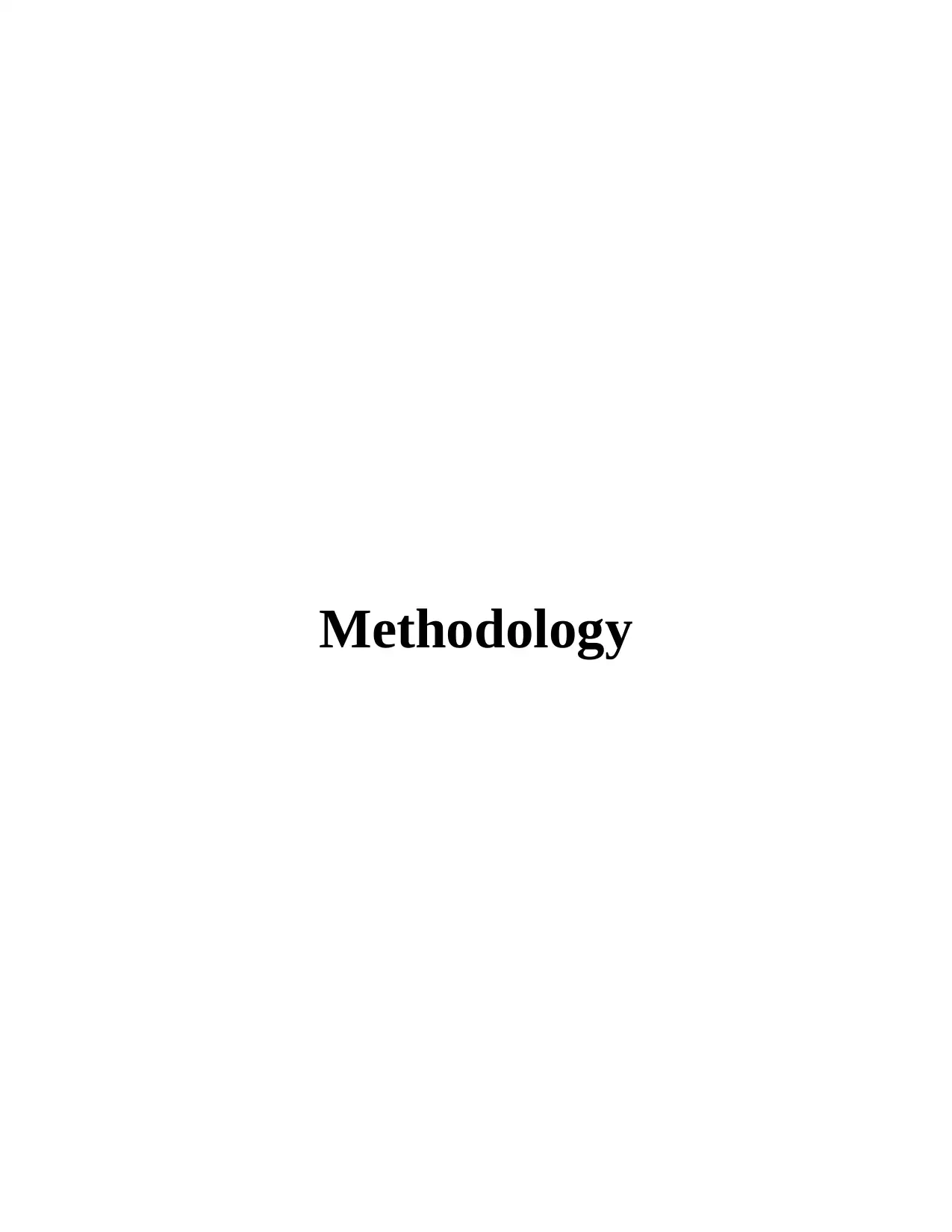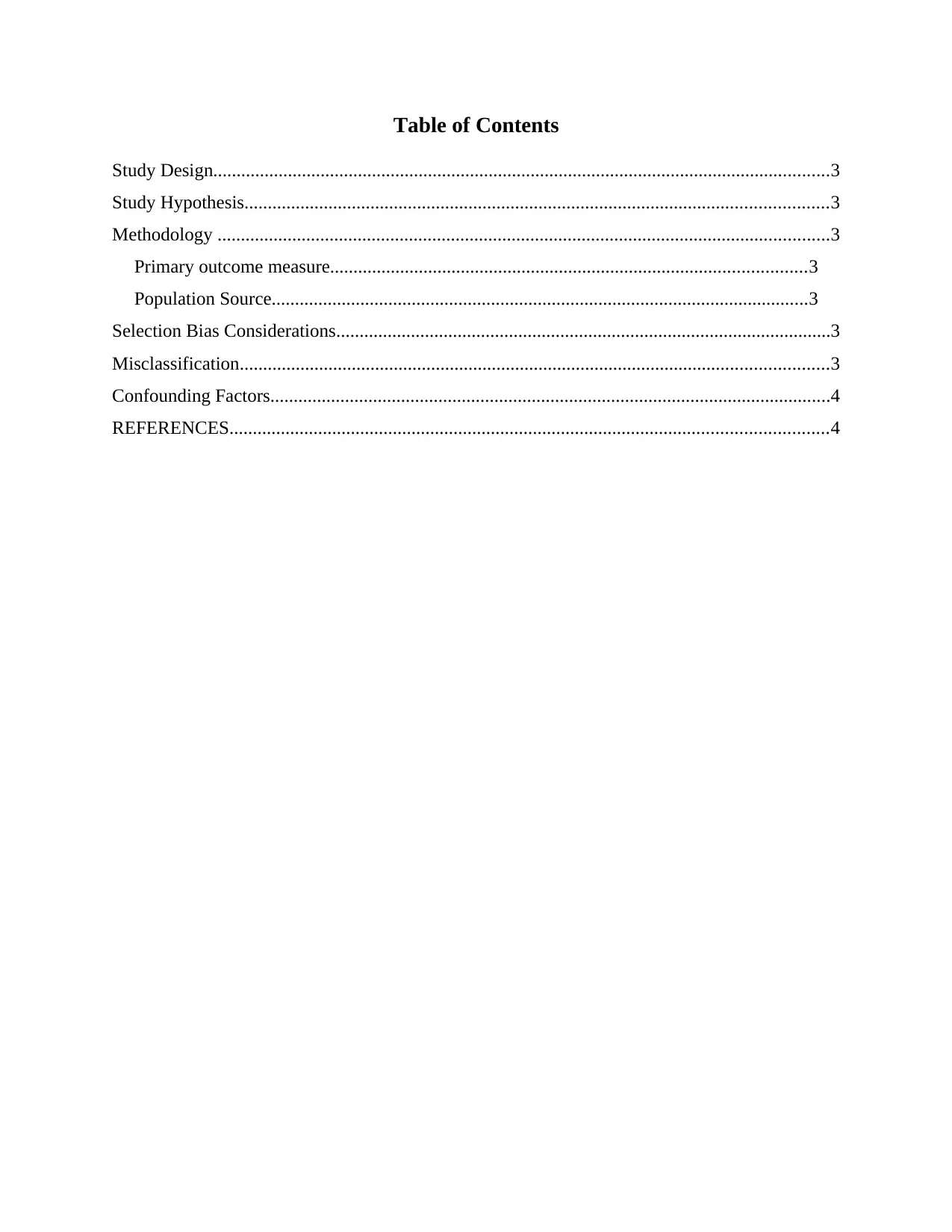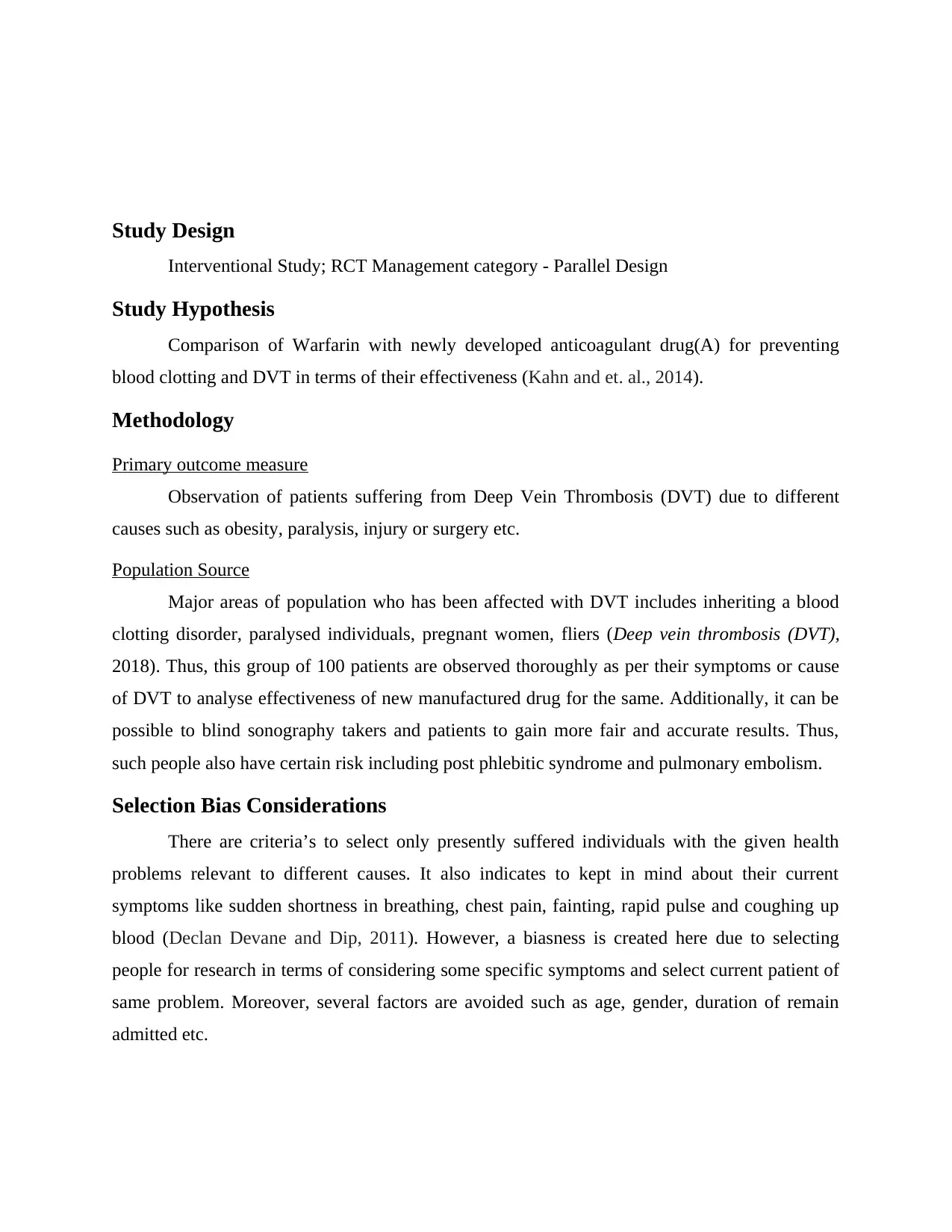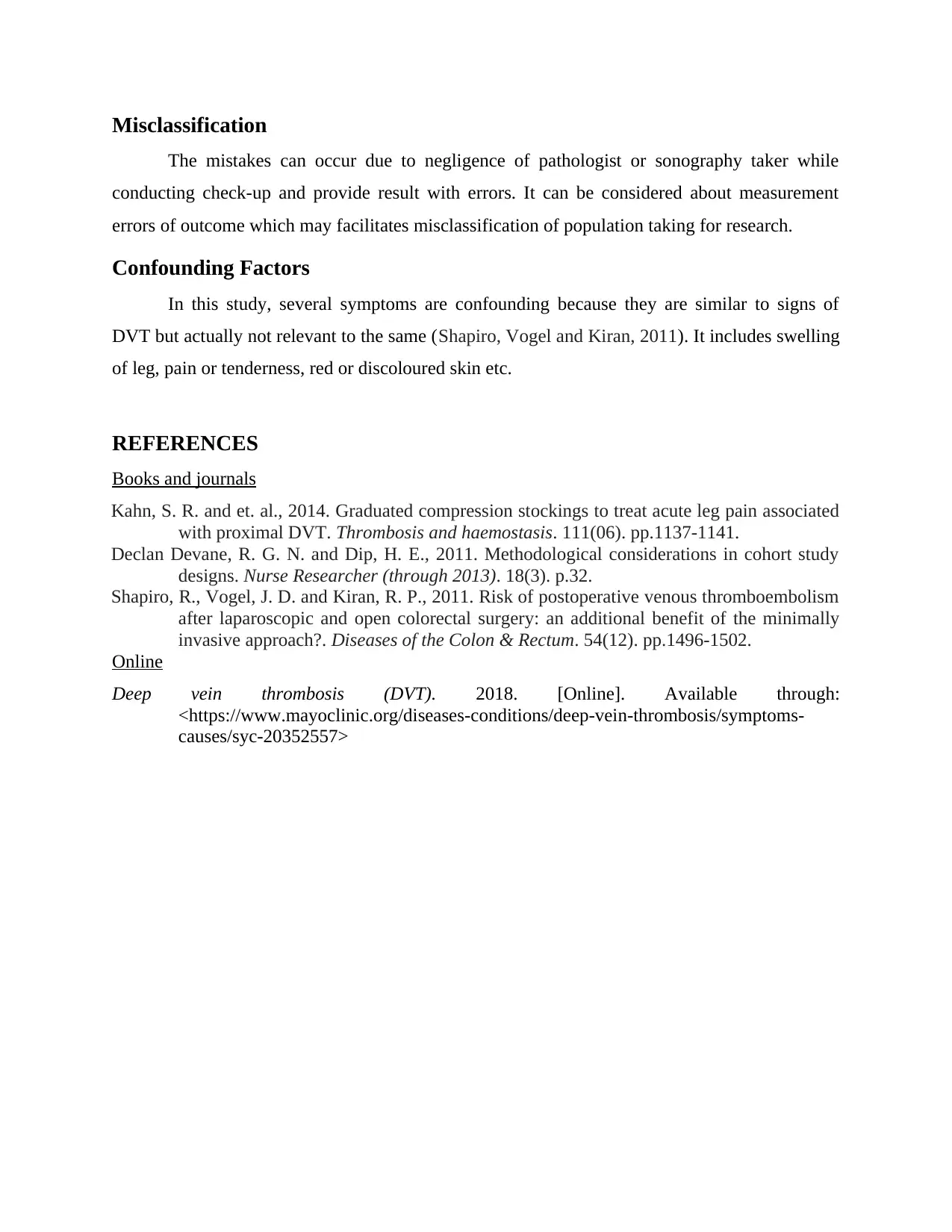Evaluating Warfarin and New Anticoagulant for DVT Prevention
VerifiedAdded on 2020/10/22
|4
|555
|97
AI Summary
The assignment explores the comparison of Warfarin with a newly developed anticoagulant drug for preventing blood clotting and DVT. It examines the study design, population source, selection bias considerations, misclassification, and confounding factors relevant to this research topic.
Contribute Materials
Your contribution can guide someone’s learning journey. Share your
documents today.

Methodology
Secure Best Marks with AI Grader
Need help grading? Try our AI Grader for instant feedback on your assignments.

Table of Contents
Study Design....................................................................................................................................3
Study Hypothesis.............................................................................................................................3
Methodology ...................................................................................................................................3
Primary outcome measure......................................................................................................3
Population Source...................................................................................................................3
Selection Bias Considerations..........................................................................................................3
Misclassification..............................................................................................................................3
Confounding Factors........................................................................................................................4
REFERENCES................................................................................................................................4
Study Design....................................................................................................................................3
Study Hypothesis.............................................................................................................................3
Methodology ...................................................................................................................................3
Primary outcome measure......................................................................................................3
Population Source...................................................................................................................3
Selection Bias Considerations..........................................................................................................3
Misclassification..............................................................................................................................3
Confounding Factors........................................................................................................................4
REFERENCES................................................................................................................................4

Study Design
Interventional Study; RCT Management category - Parallel Design
Study Hypothesis
Comparison of Warfarin with newly developed anticoagulant drug(A) for preventing
blood clotting and DVT in terms of their effectiveness (Kahn and et. al., 2014).
Methodology
Primary outcome measure
Observation of patients suffering from Deep Vein Thrombosis (DVT) due to different
causes such as obesity, paralysis, injury or surgery etc.
Population Source
Major areas of population who has been affected with DVT includes inheriting a blood
clotting disorder, paralysed individuals, pregnant women, fliers (Deep vein thrombosis (DVT),
2018). Thus, this group of 100 patients are observed thoroughly as per their symptoms or cause
of DVT to analyse effectiveness of new manufactured drug for the same. Additionally, it can be
possible to blind sonography takers and patients to gain more fair and accurate results. Thus,
such people also have certain risk including post phlebitic syndrome and pulmonary embolism.
Selection Bias Considerations
There are criteria’s to select only presently suffered individuals with the given health
problems relevant to different causes. It also indicates to kept in mind about their current
symptoms like sudden shortness in breathing, chest pain, fainting, rapid pulse and coughing up
blood (Declan Devane and Dip, 2011). However, a biasness is created here due to selecting
people for research in terms of considering some specific symptoms and select current patient of
same problem. Moreover, several factors are avoided such as age, gender, duration of remain
admitted etc.
Interventional Study; RCT Management category - Parallel Design
Study Hypothesis
Comparison of Warfarin with newly developed anticoagulant drug(A) for preventing
blood clotting and DVT in terms of their effectiveness (Kahn and et. al., 2014).
Methodology
Primary outcome measure
Observation of patients suffering from Deep Vein Thrombosis (DVT) due to different
causes such as obesity, paralysis, injury or surgery etc.
Population Source
Major areas of population who has been affected with DVT includes inheriting a blood
clotting disorder, paralysed individuals, pregnant women, fliers (Deep vein thrombosis (DVT),
2018). Thus, this group of 100 patients are observed thoroughly as per their symptoms or cause
of DVT to analyse effectiveness of new manufactured drug for the same. Additionally, it can be
possible to blind sonography takers and patients to gain more fair and accurate results. Thus,
such people also have certain risk including post phlebitic syndrome and pulmonary embolism.
Selection Bias Considerations
There are criteria’s to select only presently suffered individuals with the given health
problems relevant to different causes. It also indicates to kept in mind about their current
symptoms like sudden shortness in breathing, chest pain, fainting, rapid pulse and coughing up
blood (Declan Devane and Dip, 2011). However, a biasness is created here due to selecting
people for research in terms of considering some specific symptoms and select current patient of
same problem. Moreover, several factors are avoided such as age, gender, duration of remain
admitted etc.

Misclassification
The mistakes can occur due to negligence of pathologist or sonography taker while
conducting check-up and provide result with errors. It can be considered about measurement
errors of outcome which may facilitates misclassification of population taking for research.
Confounding Factors
In this study, several symptoms are confounding because they are similar to signs of
DVT but actually not relevant to the same (Shapiro, Vogel and Kiran, 2011). It includes swelling
of leg, pain or tenderness, red or discoloured skin etc.
REFERENCES
Books and journals
Kahn, S. R. and et. al., 2014. Graduated compression stockings to treat acute leg pain associated
with proximal DVT. Thrombosis and haemostasis. 111(06). pp.1137-1141.
Declan Devane, R. G. N. and Dip, H. E., 2011. Methodological considerations in cohort study
designs. Nurse Researcher (through 2013). 18(3). p.32.
Shapiro, R., Vogel, J. D. and Kiran, R. P., 2011. Risk of postoperative venous thromboembolism
after laparoscopic and open colorectal surgery: an additional benefit of the minimally
invasive approach?. Diseases of the Colon & Rectum. 54(12). pp.1496-1502.
Online
Deep vein thrombosis (DVT). 2018. [Online]. Available through:
<https://www.mayoclinic.org/diseases-conditions/deep-vein-thrombosis/symptoms-
causes/syc-20352557>
The mistakes can occur due to negligence of pathologist or sonography taker while
conducting check-up and provide result with errors. It can be considered about measurement
errors of outcome which may facilitates misclassification of population taking for research.
Confounding Factors
In this study, several symptoms are confounding because they are similar to signs of
DVT but actually not relevant to the same (Shapiro, Vogel and Kiran, 2011). It includes swelling
of leg, pain or tenderness, red or discoloured skin etc.
REFERENCES
Books and journals
Kahn, S. R. and et. al., 2014. Graduated compression stockings to treat acute leg pain associated
with proximal DVT. Thrombosis and haemostasis. 111(06). pp.1137-1141.
Declan Devane, R. G. N. and Dip, H. E., 2011. Methodological considerations in cohort study
designs. Nurse Researcher (through 2013). 18(3). p.32.
Shapiro, R., Vogel, J. D. and Kiran, R. P., 2011. Risk of postoperative venous thromboembolism
after laparoscopic and open colorectal surgery: an additional benefit of the minimally
invasive approach?. Diseases of the Colon & Rectum. 54(12). pp.1496-1502.
Online
Deep vein thrombosis (DVT). 2018. [Online]. Available through:
<https://www.mayoclinic.org/diseases-conditions/deep-vein-thrombosis/symptoms-
causes/syc-20352557>
1 out of 4
Your All-in-One AI-Powered Toolkit for Academic Success.
+13062052269
info@desklib.com
Available 24*7 on WhatsApp / Email
![[object Object]](/_next/static/media/star-bottom.7253800d.svg)
Unlock your academic potential
© 2024 | Zucol Services PVT LTD | All rights reserved.